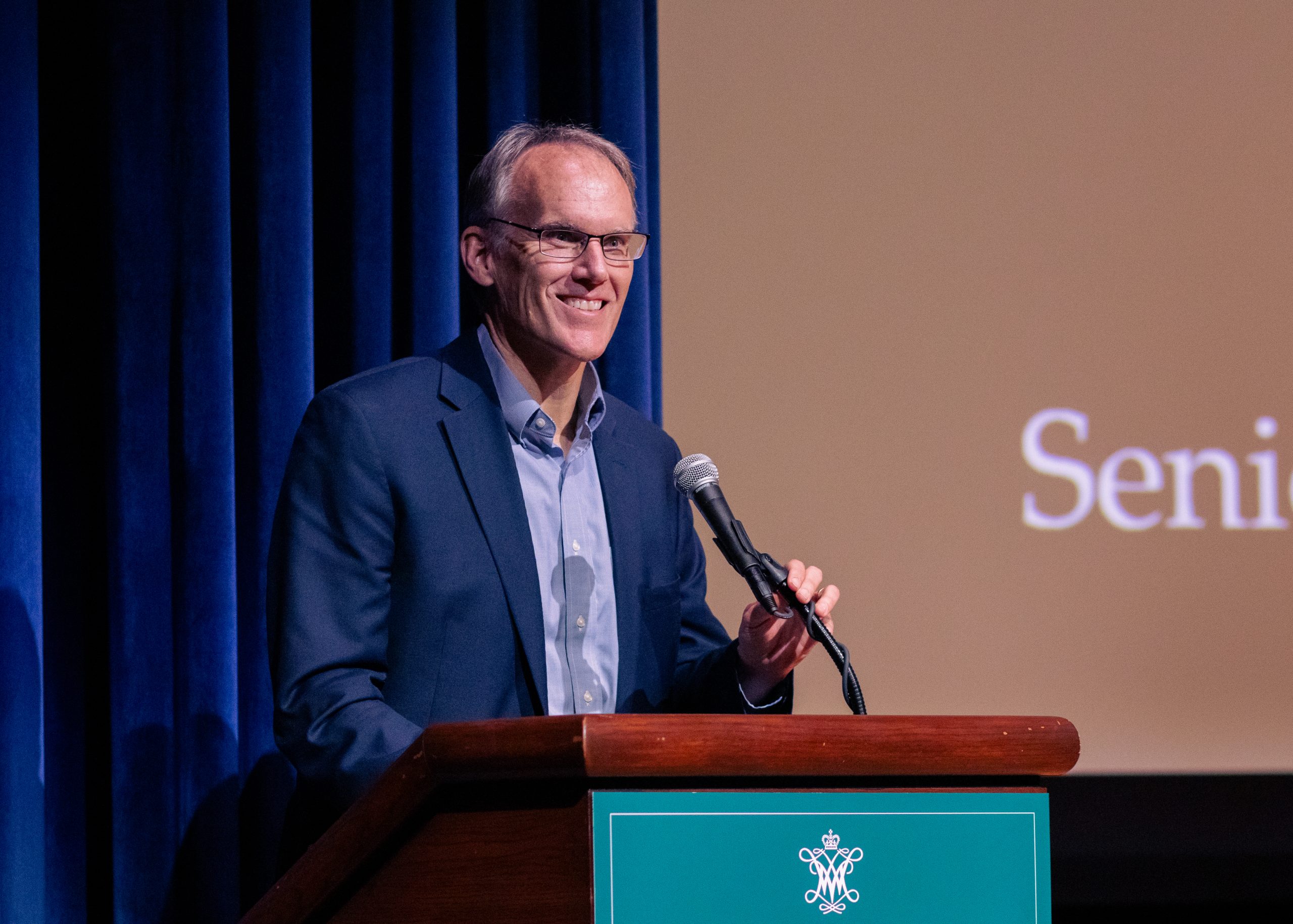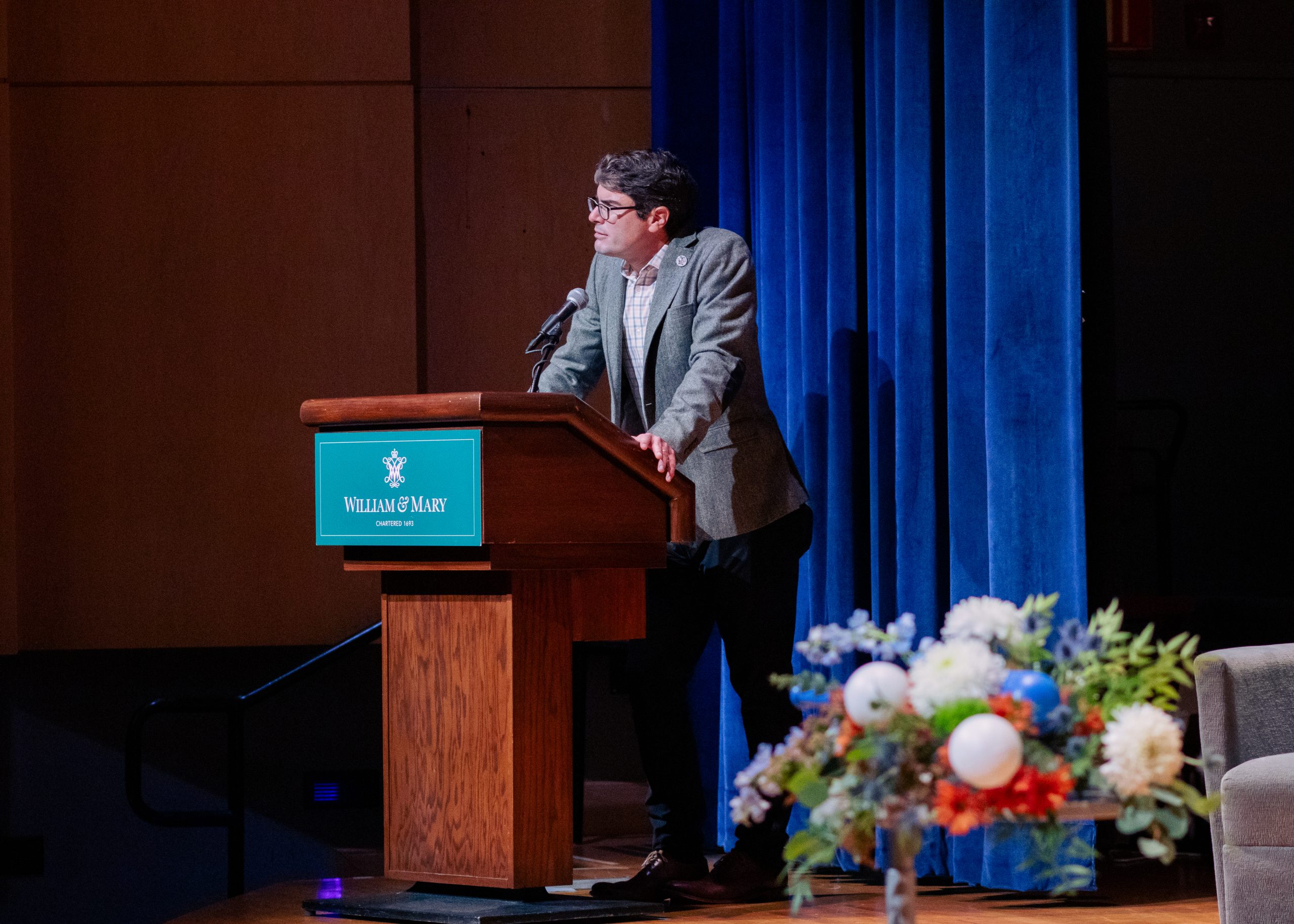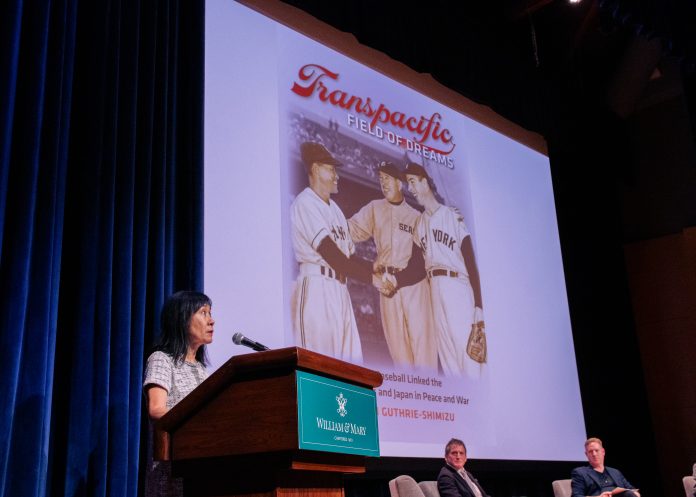Friday, Oct. 27, the College of William and Mary U.S.-Japan Baseball Diplomacy Project held its “150 Years of U.S.-Japan Baseball Diplomacy” symposium in the Sadler Center’s Commonwealth Auditorium. Professor of government and Co-Director of the Social Science Research Methods Center Marcus Holmes, associate professor of history Hiroshi Kitamura and Isabelle and Jerome E. Hyman Distinguished University Professor and Director of public policy Paul Manna hosted the symposium with the help of their team of undergraduate students. Sponsored by the United States Department of State, the conference celebrated the role of baseball in shaping relations between the United States and Japan.
The symposium centered on diplomacy and emphasized cooperation, resulting from an inter-organizational collaboration between the Japan Retired Foreign Player Association, Major League Baseball Players Trust and North American Sake Brewery, professors from Rice University and Western Washington University, as well as the College’s departments of government, history and modern languages and literatures. The symposium also featured interdisciplinary collaboration with faculty from the department of kinesiology and between students studying international relations, government, history, economics, public policy, data science, psychology and sociology.
The symposium began with opening remarks from Holmes, United States Ambassador to Japan Rahm Emanuel and William and Mary baseball head coach Mike McRae. After Holmes began the symposium with opening remarks, Senior Vice President of MLB International Jim Small delivered a keynote speech about his experience with baseball’s cultural significance. Small recalled an interaction with a young man who survived the 2011 Tohoku earthquake and tsunami, in which the young man told Small, “If you get knocked down seven times, you get up eight times.” The same young man who offered Small this advice was the star pitcher of a Japanese youth baseball team who beat an American team 8-1 a few weeks later.

“If you want to know what baseball means to Japan and what Japan means to baseball, it’s a 13-year-old kid trying to console me by saying, ‘It’s okay, I’ve got this,’” Small said.
Professor of history at Rice University Sayuri Guthrie Shimizu shared a brief history of U.S.-Japan baseball diplomacy to lay the groundwork for the rest of the day’s programming. She explained how Horace Wilson introduced the sport to Japan in 1872 while he was teaching at Kaisei Gakko University. Later named Tokyo Imperial University and currently known as the University of Tokyo, this institution eventually came to be known as the site for the first formal baseball team in the country.
Shimizu also shared how she came to be involved in the research surrounding the U.S.-Japanese baseball diplomacy. She recalled coming to the realization that there is an inseparable connection between the impact of baseball and the history of U.S.-Japanese diplomacy as a whole.
“I was not a sports historian, but I’m a U.S.-Japanese diplomatic historian,” Shimizu said. “Once I delved into the U.S. Japanese relations, there were certain inflection points that were very, very important that constituted a great general arc of the U.S. Japanese history, and in each inflection point, baseball was there. So that’s why I was like, ‘Why is this so important?’ And then I began to research, and that’s how I got involved.”
Looking forward, Shimizu emphasized that she looks forward to seeing a positive future impact imparted by U.S.-Japanese baseball diplomacy, defining success for this kind of sports diplomacy as the transformation of the experiences lived by future generations.
“In my way of thinking, it’s just how many young boys and girls play baseball and then it becomes part of their daily life and their lived experience and they look at the other ones, Americans or the Japanese, as a sort of equal partner in this sporting community,” Shimizu said. “If they can really start to think of themselves that way, I would say that’s really the major successful cultural diplomacy.”
Afterwards, professor of journalism at Western Washington University Derek Moscato further discussed these ideas of public diplomacy and soft power in the context of U.S.-Japan relations using the example of Ichiro Suzuki’s illustrious career in the MLB. As Moscato described it, public diplomacy and soft power are concepts within international relations that refer to a country’s ability to persuade others without the use of force or coercion. In essence, soft power uses attraction to influence others, often through aspects of a country’s culture.
Moscato expanded on this idea by referencing a 2002 article titled “Japan’s Gross National Cool,” written by Douglas McGray. In the article, McGray argued Japan was in the midst of a shift from an economic superpower to the potential of a cultural superpower, referencing the impact of Japanese cultural exports such as anime, food, fashion, architecture, design and in the context of this symposium, sport.
This article was published less than a year after Suzuki’s MLB debut in 2001. Moscato elaborated that Suzuki’s popularity in both the United States and Japan was evidence of the shift that McGray foresaw and evidence of legitimacy of public diplomacy and soft power.
“Japanese baseball star Ichiro Suzuki left Japan to bat lead-off for the Seattle Mariners,” Moscato said. “Japan sports shops were already filled with official Mariners jerseys and baseball caps in anticipation. Japanese television covered every Mariners game live despite a 12-hour difference.”
Moscato reiterated that although U.S-Japanese baseball diplomacy may seem contemporary with the success of this year’s World Baseball Classic and the monumental popularity of Japanese baseball star Shohei Ohtani of the Los Angeles Angels, Suzuki’s influence two decades ago set the foundation for the legacy that Japanese players like Ohtani carry when playing in the United States today.
“Ichiro was a cultural intermediary who has found the philosophy of bi-national success and the embodiment of what was possible through mutual exchange and cross-cultural learning,” Moscato said. “[Ichiro] was real proof that Japan could compete on a larger stage of culture and sport, serving as a metaphor for Japan’s influence in arenas like cinema, food, architecture and design.”
“Ichiro was a cultural intermediary who has found the philosophy of bi-national success and the embodiment of what was possible through mutual exchange and cross-cultural learning,” Moscato said. “[Ichiro] was real proof that Japan could compete on a larger stage of culture and sport, serving as a metaphor for Japan’s influence in arenas like cinema, food, architecture and design.”
Baseball journalist and specialist Brad Lefton shared a few examples of some of the many ways Japan has influenced baseball America throughout the years he has covered the sport. Lefton began his discourse by discussing the innovative nature of Japanese training and condition practices in the late 1990s. A significant amount of Japanese training and conditioning actions centered around the concept of pre-habilitation, which involves preventing injuries and lessening the number of players who require rehabilitation.
While this practice may seem commonplace in professional sports today, nearly three decades ago, such training methods were revolutionary. Effectiveness of the impact of pre-habilitation is still observed today, with about half of MLB teams having a Japanese member of their training staff.
Lefton highlighted teams like Cincinnati, Miami, Boston and Houston as particular points of interest, as they have Japanese trainers, but no Japanese players.
“Many Japanese players typically bring a trainer over with them because major league teams want that player to be comfortable here,” Lefton said. “But, then what happens in the case of teams like Cincinnati, Miami, Boston and Houston, is when the player is not re-signed, management feels compelled to hold on to the trainer. And, so the trainers have stayed with these organizations, even though the Japanese player isn’t there anymore because the management and other players feel so good about the training that they’re getting from these Japanese trainers.”
Lefton then discussed Japan’s influence on baseball hitting in America through the story of Philadelphia Phillies’ advisor Charlie Manuel. A former MLB player, Manuel had an unremarkable six-year career in the MLB, batting an average of .198 and only hitting four home runs. However, in 1996 he crossed the Pacific Ocean to play ball in Japan. Over his four seasons in Japan, Manuel hit a .303 average with an on base plus slugging percentage of 1.988. He credits his Yakult Swallows manager Hiroshi Arakawa and Japanese baseball player Sadaharu Oh for revolutionizing his bat swing.
While Manuel did not imitate Oh’s famous flamingo batting stance, he still applied the same technique as Oh and Arakawa, who conceptualized the importance of a strong core for balance and generating power from the legs. Today, such concepts regarding batting stance are widely accepted — however, Oh and Arakawa emphasized such methods back in the 1960s.
After a short intermission, Kitamura moderated a conversation between former baseball players Masanori “Mashi” Murakami and Greg “Boomer” Wells.
Murakami was the first Japanese player to play in the MLB, making his debut for the San Francisco Giants on Sept. 1, 1964. Murakami initially arrived in the United States as a part of a minor league working agreement between the Giants and the Nankai Hawks, Murakami’s Japanese team.
Though his stint in the MLB was short-lived, with Murakami returning to Japan after the 1965 season, Murakami was a pioneer for Japanese players in the American major leagues, bridging two baseball cultures and starting the influx of following Japanese talent entering the MLB.

Wells helped solidify the belief that American players could have successful and lucrative careers playing baseball in Japan. After a few brief stints in the MLB, Wells signed with the Hankyu Braves of the Nippon Professional Baseball, where he found considerable success, winning Pacific League MVP and the NPB Triple Crown in 1984.
Before Wells, it was common for American baseball players to only go over to Japan towards the end of their careers to make one last check before retiring.
“I’m like, okay, I’m too young not to be playing; I don’t want to go there to make one last check and be through playing baseball,” Wells said. “So, I fought it and after I didn’t have a choice, then I went over and played. But, it just so happened that the class of players that went over with me were all in the same boat of wanting to still play baseball. So when we went over there, we kind of changed the Japanese perception of the American baseball player, because guys used to only go there to get one last check and leave.”
Other working components of the U.S.-Japan Baseball Diplomacy Project, which are in current development, include an interactive online trivia game lead by Manna, an oral history project focused on interviews with the players themselves conducted by Kitamura and a campaign to send a group of young baseball players from the Williamsburg Youth Baseball League to Kamakura, Japan for a series of exhibition games. Professor of kinesiology Amy Rains and professor of government Jackson Sasser are part of the team of coaches involved with lifting this last initiative off the ground.
The campaign will take place next August. The team of 11 and 12 year-olds from the Williamsburg Revolution travel organization was selected in due part to submitted essays explaining what benefit they would get out of going to Japan.
“These guys are going to represent the U.S. and the City of Williamsburg in the best way possible,” Rains said. “They’re going to spend ten days in Kamakura, which is an old capital city just outside of Tokyo, known for its robust history with religious shrines and temples. So, we’ll get to do a lot of sightseeing, and we are absolutely thrilled.
“These guys are going to represent the U.S. and the City of Williamsburg in the best way possible,” Rains said. “They’re going to spend ten days in Kamakura, which is an old capital city just outside of Tokyo, known for its robust history with religious shrines and temples. So, we’ll get to do a lot of sightseeing, and we are absolutely thrilled.
As Rains emphasized, cultural exchange programs such as this hold an important role in the ever-growing relationship between the United States and Japan. Not only will players from both countries be able to experience the differences in style of play, but players will be able to experience an entirely different culture.
“It’s always a really good thing to open your minds and realize that there are people all over the world that like to do the same things that we do,” Small said. “And, if that’s hitting a baseball, maybe that’s going to bring the kids over here and the kids in Japan closer together.”
The closing keynote for the night was delivered by none other than former MLB player, coach, manager and broadcaster Bobby Valentine. Valentine discussed the impact baseball can have on bringing people of all backgrounds together.
“Why am I so lucky to be at this venue listening to these prior guests share their wisdom, experience and love for baseball,” Valentine said.

